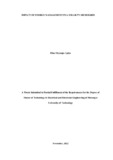Impact of Energy Management in a Solar PV Microgrid
Abstract
Fossil fuel accounts for a bigger percentage of primary energy sources in the world. Studies show that the world energy demand is on the rise but the real sources of fossil fuel decline each day. Major oil producing countries are likely to deplete their oil fields within a decade if the current rate of fossil fuel production maintained. Generation of energy through fossil fuel burning causes Greenhouse Gas Emission into the atmosphere causing global warming. Generation of energy through renewable energy sources provides a better alternative to cope with the declining oil reserves and combat climate change. Solar photovoltaic is a suitable alternative clean and environmentally friendly renewable energy source, which uses solar photovoltaic technology. This thesis discussed the impact of energy management on a solar photovoltaic microgrid and tried to narrow the research gap left by various researchers who provided related literature about the work. Modeling, energy management and the impact of installing solar PV system to supplement utility grid electricity is studied. This work was conducted using a mathematical model of the PV based microgrid that was simulated using MATLAB/Simulink software. The laboratory implementation was done using hardware components and real-time energy management using microcontroller. The prediction of solar PV power generation on a medium-term basis was done using PVsyst photovoltaic software while a short-term basis was implemented using Application Programming Interface software. The energy management strategy is such that the solar PV module becomes the priority power source to supply three loads while charging the battery when irradiance is sufficient. At low irradiance, the battery supplies the loads and when the discharge is below a specified limit, the utility grid electricity supplies the loads. Simulation results show that the solar PV module serve the loads and charge the battery during daytime while the grid remained as a standby power source. However, the microcontroller disables the loads from the PV system source when the threshold of charging the battery is reached. The loads are then connected to the utility grid. In the simulation of the solar resource software, the solar pv generation for seven days on the month of March 2022 indicated a maximum and minimum generation of 720.82 Wh and 498.96 Wh respectively. The financial analysis of installing 90 W grid-tied PV solar system without subsidy is US$ 384. The 90 W module costs US$ 486 and has a service life of 25 years and payback period of 11 years. During the lifespan of the solar PV module, 1,333.78 kg of CO2 emitted into the atmosphere are saved.

